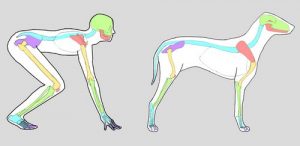Canine Vs Human Bone Structure

The key differences between canine and human bone structures are:
An adult human body has 206 bones compared with 319-321 for a dog.
There is much greater density in canine bones than in human bones. The dog’s forelimb and rear limb are a quarter thicker in diameter than the human upper arm and thigh. Canine bones are also less porous.
The two bones of the human forearm are separate, but the two bones of the dog’s forelimbs are often fused together.
Dogs have a tail, and the male dog’s penis has a bone in it.
Dogs’ toes are bent to reduce impact on the bones, whilst human finger bones are straight. The human thumb is a vestigial part of the dog’s foot.
Dogs have long muzzles with grasping and tearing teeth, whilst humans have a flat-faced skull and less specialised teeth. The braincase dominates the human skull, but is relatively smaller in dogs (and particularly in the Cavalier King Charles spaniel, leading to syringomyelia)
Due to their shoulder structure, humans can reach over their heads.
Dogs’ shoulder bones are designed to support the weight of their upper body, unlike the human shoulder bone.
The flexible spine in the dog acts like a suspension bridge, whilst the human spine acts like a support column.
In humans, legs are longer than arms, whereas in dogs they are approximately equal in size. Also in humans the femur is a particularly long bone, whilst in dogs this is a much shorter bone (as seen in the diagram above).
